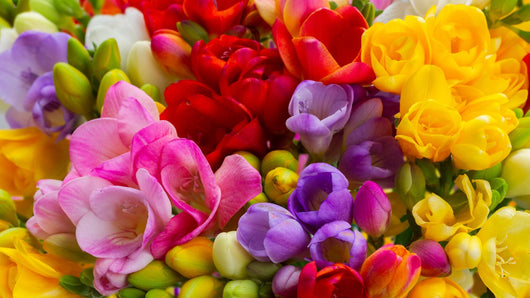
Chicago’s climate is notorious for its drastic seasonal changes, from freezing winters to hot, humid summers. If you love fresh flowers, you might have noticed how challenging it can be to keep them vibrant amid these shifts. Whether you're decorating your home, planning an event, or caring for a bouquet from a loved one, learning how to preserve the beauty of your flowers through every season is essential.
In this guide, we’ll explore the best tips and tricks for maintaining fresh flowers in Chicago’s ever-changing weather conditions.
Understanding Chicago’s Climate and Its Effect on Flowers
Chicago experiences four distinct seasons, each posing unique challenges to fresh flowers:
-
Winter (December–February): Dry indoor heating can quickly dehydrate flowers, causing them to wilt.
-
Spring (March–May): Fluctuating temperatures and occasional frost can shorten flower lifespans.
-
Summer (June–August): Heat and humidity can speed up the decomposition process.
-
Fall (September–November): Cool nights may help flowers last longer, but sudden temperature drops can be harmful.
With these seasonal changes in mind, let’s dive into the best ways to keep your flowers looking fresh year-round.
1. Choosing the Right Flowers for Each Season
Certain flowers thrive better in different seasons. Here are some ideal choices:
Best Flowers for Winter
-
Amaryllis
-
Poinsettias
-
Roses (with proper care)
-
Cymbidium orchids
Best Flowers for Spring
-
Tulips
-
Daffodils
-
Hyacinths
-
Peonies
Best Flowers for Summer
-
Sunflowers
-
Lilies
-
Zinnias
-
Dahlias
Best Flowers for Fall
-
Chrysanthemums
-
Marigolds
-
Dahlias
-
Asters
By choosing flowers that naturally thrive in the season, you’ll extend their lifespan and maintain their vibrancy.
2. Keeping Flowers Fresh in Cold Chicago Winters
Winter’s biggest threats to fresh flowers are dry air and temperature extremes. Here’s how to combat them:
-
Keep flowers away from heating vents and radiators. Heat dries out petals and leaves, causing premature wilting.
-
Use lukewarm water. Cold water can shock the flowers, while warm water helps stems absorb nutrients better.
-
Increase humidity. Placing a bowl of water near your flowers or misting them lightly can prevent them from drying out.
-
Trim stems at an angle. This maximizes water absorption, keeping your flowers hydrated longer.
-
Change the water regularly. Every two days, replace the water and add flower food to keep bacteria at bay.
3. Protecting Flowers from Spring’s Temperature Swings
Spring in Chicago can be unpredictable—warm one day, freezing the next. Follow these tips to help your flowers adjust:
-
Avoid placing flowers near open windows. Sudden gusts of cold wind can damage delicate petals.
-
Bring outdoor potted flowers inside on chilly nights. Frost can ruin fresh blooms overnight.
-
Use floral preservatives. These contain nutrients that extend the life of cut flowers.
-
Trim excess leaves. Leaves sitting in water rot quickly, producing bacteria that shorten the bouquet’s lifespan.
4. Preventing Wilting in Hot and Humid Summers
Chicago summers can be harsh on fresh flowers due to extreme heat and high humidity. Keep your flowers vibrant with these methods:
-
Store flowers in a cool, shaded area. Direct sunlight accelerates dehydration.
-
Use ice cubes in the vase water. This keeps the water temperature cool, slowing the aging process.
-
Mist the petals. A fine spray of water can help maintain moisture levels.
-
Refresh water daily. Bacteria multiply faster in warm weather, so changing the water daily is crucial.
-
Choose heat-resistant flowers. Sunflowers, zinnias, and orchids withstand summer heat better than more delicate varieties.
5. Extending the Life of Flowers in Fall’s Cooler Temperatures
Fall’s moderate temperatures can actually help flowers last longer, but sudden cold snaps can be damaging. Follow these tips:
-
Keep flowers away from cold drafts. Just like in spring, unexpected cold breezes can harm your flowers.
-
Use room-temperature water. Unlike summer, ice water isn’t necessary; moderate temperatures work best.
-
Don’t overcrowd flowers in the vase. Good air circulation prevents mold and bacteria growth.
-
Remove wilting flowers immediately. One dying flower can release ethylene gas, which speeds up the decay of the rest.
6. General Tips for Year-Round Flower Care
No matter the season, these essential care tips will keep your flowers looking fresh for as long as possible:
-
Cut stems at an angle. This increases surface area for water absorption.
-
Use a clean vase. Bacteria in dirty vases shortens flower lifespan.
-
Change water frequently. Every two days is ideal.
-
Avoid placing flowers near fruit. Ripening fruit releases ethylene gas, which speeds up wilting.
-
Use homemade flower food. A mix of sugar (to feed the flowers), vinegar (to kill bacteria), and a few drops of bleach (to prevent mold) works wonders.
Conclusion
Chicago’s changing seasons make it tricky to keep flowers fresh, but with the right strategies, you can enjoy beautiful blooms all year long. Whether you’re battling winter dryness, spring fluctuations, summer heat, or fall chills, following these expert tips will help your flowers thrive in any weather.
Next time you bring home a fresh bouquet or plan floral decorations for an event, remember these season-specific tricks to keep your flowers vibrant and stunning for as long as possible.